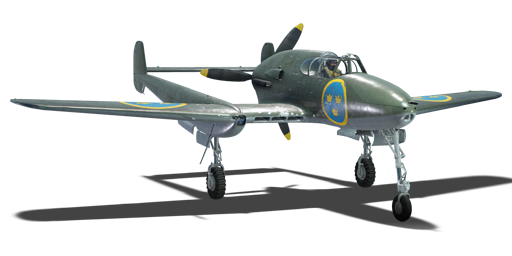



The SAAB 21 rose from the drawing board in anticipation of World War 2. The development of this aircraft came with the need to develop a national fighter without having to rely on foreign designs like the Re.2000 and CR.42. The Saab 21's unique twin-boom layout, offering exceptional pilot visibility and easy maintenance, was chosen and fitted with a modified German Daimler-Benz DB 605 engine. Despite missing wartime action, the Saab 21 remained relevant, with over 300 produced to bolster Sweden's air defenses.
Introduced in Update 1.95 "Northern Wind" along with the initial Swedish air tree, the J21A-1 is quite sluggish but a heavily durable fighter. It has a top speed of 640 km/h, courtesy of the Daimler-Benz DB 605B engine; however, the speed and manoeuvrability are not the most impressive characteristics of the aircraft: it's the weaponry it comes armed with. A total of four 13.2 mm Akan m/39A and a 20 mm Akan m/41A makes it a heavy firepower-reliant fighter able to eliminate any enemy aircraft with ease.
flaps
flaps
flaps
brake
| Belt | Belt filling | Armor penetration (mm) at a distance: | |||||
|---|---|---|---|---|---|---|---|
| 10 m | 100 m | 500 m | 1000 m | 1500 m | 2000 m | ||
| HEF-T/AP-T/HEF-T/AP-T | 38 | 35 | 24 | 16 | 10 | 6 | |
| HEFI-T/HEFI-T/HEFI-T/AP-T | 38 | 35 | 24 | 16 | 10 | 6 | |
| AP-T/AP-T/AP-T/HEF-T | 38 | 35 | 24 | 16 | 10 | 6 | |
| Belt | Belt filling | Armor penetration (mm) at a distance: | |||||
|---|---|---|---|---|---|---|---|
| 10 m | 100 m | 500 m | 1000 m | 1500 m | 2000 m | ||
| HEF-T/AP | 28 | 26 | 19 | 12 | 8 | 5 | |
| HEF-T/AP/AP/AP | 28 | 26 | 19 | 12 | 8 | 5 | |
| HEF-T/HEF-T/AP/HEF-T | 28 | 26 | 19 | 12 | 8 | 5 | |
| AP | 28 | 26 | 19 | 12 | 8 | 5 | |












Flight performance | |
|---|---|
Survivability |
|---|
Weaponry | |
|---|---|